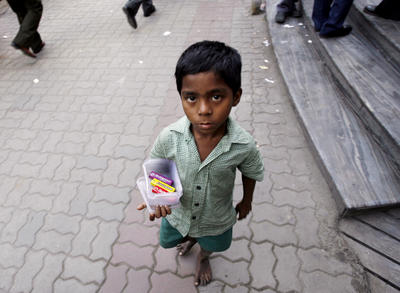Few people born into poverty in India, no matter how smart or hard working, have had success finding high-level employment. Individuals whose parents were poor tend to remain poor in later life, according to a recent study. The study interviewed more than 2,000 new entrants to a variety of engineering colleges, business schools and civil services, each a highly sought after destination among India’s youth. It looked not only at top-tier institutions — such as the Indian Institutes of Technology and Management and the Indian Administrative Service — but also at middle- and lower-tier colleges and lower-ranked civil services.
The study found that in general the English-speaking urban elite dominate the higher-paying professions. The sons (and to an increasing extent, also the daughters) of salaried and self-employed professionals are themselves joining higher education in the largest numbers and taking up the higher-paying jobs.
Seventy per cent of the Indian population live in rural areas, but people educated at rural schools constitute no more than ten per cent of the intake at any of the gateway institutions in the study. The longer the time spent at rural schools, the greater the disadvantage tends to be. Family wealth and caste background also make a considerable difference. Individuals belonging to Scheduled Castes (SCs) and Scheduled Tribes (STs) are not represented in anywhere near their population proportions, especially among the top private institutions. Any combination of disadvantages — being rural and poor, or SC/ST and rural, or the child of less educated parents and female — is almost fatal to one’s chances of entry. Only a handful have managed to gain admission, even in the lowest-tier institutions.
The study revealed a possible way out of this discouraging situation. Follow-up interviews with ‘outliers’ — those few individuals who despite facing long odds have made it into one of these institutions — showed how, to a considerable extent, ‘soft skills’ can break down these socio-economic disadvantages. The absence of these soft skills — which the study defines as access to information, role models, career guidance and motivation — holds back talented individuals from traditionally under-represented communities. People growing up in remote rural areas and city slums have little access to the kinds of information resources that urban middle-class families abundantly possess and take for granted. Few students in poor rural areas are aware of the opportunities offered to those in urban areas. Even for those who somehow come to know about these possibilities the road leading to their achievement remains uncharted, unclear, and filled with risks. Despite investing heavily in higher education many have reverted to the kinds of low-paid jobs typically held by less educated people.
The few disadvantaged individuals who have nevertheless made it into these gateway institutions have almost invariably benefited from the advice and ongoing assistance by a helpful individual who raised their aspirations and regularly provided information, direction and career guidance. But not everyone has access to these providers of soft skills. To lift social mobility in India, institutions and educational programs need to be set up to help increase access to this information.
Investing in soft skills can help make up for socio-economic disadvantages. More equal societies, such as Japan, Denmark and Sweden, among richer countries, and Costa Rica and South Korea, among middle-income ones, have invested in building public programs — including career counselling agencies, mentoring programs, employment exchanges, textbooks detailing diverse career paths, interactive websites, radio and TV links, and so on — that helped raise social mobility across the board. It’s time for India to do the same.
Programs that start by enabling even a handful of individuals from poorer rural and slum communities to achieve positions of high standing will act as a crucial stimulus, showing the way ahead to many others. Parents who are confident that their children have a real chance of a bright and prosperous future will pay more attention to their children’s education, holding schoolteachers more effectively to account. Developing better access to these soft skills could unleash a wider bottom-up dynamic, raising the productivity of top-down initiatives.
Anirudh Krishna is Professor of Public Policy and Political Science at Duke University.

